Multimedia Gallery
GeoPRISMS Aleutian Islands project (Image 1)
The caldera of the Okmok volcano with Vsevidof and Recheshnoi volcanoes in the distance. Okmok is a 6-mile-wide caldera that occupies most of the eastern end of Umnak Island, located 75 miles southwest of Dutch Harbor, Unalaska, in the eastern Aleutian Islands. Okmok last erupted in 2008 with energetic, intermittent ash emissions from several vents within the caldera.
Scientists from 11 institutions are studying the 1,550-mile-long Aleutian Arc as part of the National Science Foundation's (NSF) GeoPRISMS (Geodynamic Processes at Rifting and Subducting Margins) program. The arc extends from the Alaska mainland west toward Kamchatka, Russia, and forms the northern part of the tectonically active "ring of fire" girding the Pacific Ocean basin. Many of Alaska's more than 130 volcanoes are located along the arc.
As part of GeoPRISMS, researchers will investigate the architecture, mechanics and plumbing of continental margins at subduction zones and continental rifts, including what controls geohazards such as earthquakes and volcanoes.
The researchers are conducting a geophysical survey of Okmok volcano to try and learn more about how magma forms beneath a volcano and where it is stored. They have installed an array of seismic and subsurface electrical conductivity sensors across the volcano. The earthquake waves and naturally-occurring electromagnetic currents recorded by the sensors will allow scientists to image the magma plumbing system beneath the volcano.
GeoPRISMS researchers will also gain access to volcanoes and to the seafloor below using ships. NSF's Division of Polar Programs will lend support to the project by allowing teams to share ship time aboard the Maritime Maid, a research vessel that will travel more than 800 miles along the arc and transport scientists and equipment on and off the islands. The Sikuliaq, NSF's new global research vessel operated by the University of Alaska Fairbanks as part of the U.S. academic research fleet, is also taking part in GeoPRISMS Aleutians.
"GeoPRISMS Aleutians combines state-of-the art scientific methods on land and at sea," says Candace Major, a program director in NSF's Division of Ocean Sciences, which co-funds GeoPRISMS. "The resulting knowledge can be transferred to regions around the globe that are vulnerable to similar, potentially dangerous and costly natural hazards."
[Research funded by NSF grants OCE 14-56749 and OCE 14-56710, "Collaborative Research: Magnetotelluric and Seismic Investigations of Arc Melt Generation, Deliver and Storage Beneath Okmok Volcano."]
You can read more about this research in the NSF Discovery news story Expedition to the Aleutian Islands: Geoscientists head to remote Alaska volcanoes. (Date image taken: Summer 2015; date originally posted to NSF Multimedia Gallery: Nov. 3, 2015) [Image 1 of 3 related images. See Image 2.]
Credit: Kerry Key, Scripps Institution of Oceanography
Images and other media in the National Science Foundation Multimedia Gallery are available for use in print and electronic material by NSF employees, members of the media, university staff, teachers and the general public. All media in the gallery are intended for personal, educational and nonprofit/non-commercial use only.
Images credited to the National Science Foundation, a federal agency, are in the public domain. The images were created by employees of the United States Government as part of their official duties or prepared by contractors as "works for hire" for NSF. You may freely use NSF-credited images and, at your discretion, credit NSF with a "Courtesy: National Science Foundation" notation.
Additional information about general usage can be found in Conditions.
Also Available:
Download the high-resolution JPG version of the image. (1.3 MB)
Use your mouse to right-click (Mac users may need to Ctrl-click) the link above and choose the option that will save the file or target to your computer.



